Did you ever wonder how machines and electric vehicles actually work and make decisions? How new cars are capable of parallel parking, as smooth as a well-trained private chauffeur, while for some of us it was the biggest challenge we faced up to that point in our lives. Or how the auto-pilot function of a Tesla is able to detect an accident before it happens and can take adequate measures? And what of drones, capable of flying in a straight line, zigzagging between objects and still reaching a person in need of medical help or delivering emergency supplies?
As humanity progresses, technology becomes more dominant in our lives. Compared to 100 years ago, we have come to the point where we cannot live without technology. Most tasks that we deem standard or just don’t stop and think about are already standardized. Take for example the luggage or parcel system in airports, where you leave your bags in a machine at your departure and when you get out of your plane on the other side of the world, everything is arranged and your bags arrive at their pickup point. It amazes me how well kept this immense piece or logistical technology is from the general public.
A large part of our day consists of making use of systems like this, whether we are actively using it, like smartphones, or whether it works for us with as little knowledge of its existence, to give us comfort of not thinking about the entire logistical operation, such as your luggage when going on a holiday.
Essentially, we trust devices to control a part of our lives.
For people, this has both benefits and weaknesses. What if something goes wrong? What if the device malfunctions, or worse, if it makes a decision that you would not want it to make? Without going into the endless discussion of how far technology should influence or lead our lives, I find the consideration of how much we should still have control over autonomous systems interesting. Because it is a sense of comfort, knowing that, no matter what happens, you will always be able to take matters into your own hands.
The notion of technology relieving you of certain tasks is appealing, but the sense of remaining in control speaks to me even more. This shows in our work at Dot Robot. During the design of the drive controls for Scoozy, we wanted to ensure that the user is always capable of stopping the vehicle in case of an emergency, making sure that the user is always in full control, no matter what happens. The key is that going back to a safe position must be intuitive and nearly a natural reaction. Knowing that people will react different to some situations, different ways of stopping were designed, greatly minimizing any risk.
But also additional under the hood safety-measures were taken! In the software itself, there are fail-safes to guarantee that errors are caught before something can go wrong, such as when a sensor reading is way off its nominal value. This type of redundancy is meant to create trust with the user. We believe the user is much more comfortable giving new technology a chance when they can always intervene or, as Frankie said it, do it their way.


